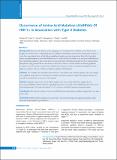Please use this identifier to cite or link to this item:
https://hdl.handle.net/20.500.14356/1808Full metadata record
| DC Field | Value | Language |
|---|---|---|
| dc.contributor.author | Shakya, P | - |
| dc.contributor.author | Aryal, S | - |
| dc.contributor.author | Aryal, R | - |
| dc.contributor.author | Mazgaeen, L | - |
| dc.contributor.author | Shah, A | - |
| dc.contributor.author | Oshi, B | - |
| dc.date.accessioned | 2023-05-23T09:19:08Z | - |
| dc.date.available | 2023-05-23T09:19:08Z | - |
| dc.date.issued | 2014 | - |
| dc.identifier.citation | ShakyaP., AryalS., AryalR., MazgaeenL., ShahA., & oshiB. (2014). Occurrence of Amino Acid Mutation (Ala98Val) Of HNF1α in Association with Type II Diabetes. Journal of Nepal Health Research Council. https://doi.org/10.33314/jnhrc.v0i0.501 | en_US |
| dc.identifier.issn | Print ISSN: 1727-5482; Online ISSN: 1999-6217 | - |
| dc.identifier.uri | http://103.69.126.140:8080/handle/20.500.14356/1808 | - |
| dc.description | Original Article | en_US |
| dc.description.abstract | Abstract Background: Maturity onset diabetes of the young type 3 is a monogenic form of diabetes. Gene defects in the Hepatocyte Nuclear Factor -1 alpha (HNF1a) causes MODY3. HNF1a gene located in the chromosome (12q24.2) codes for a transcription factor which helps in signalling of insulin exocytosis in pancreatic Beta cells. A prevalent amino acid polymorphism at codon 98-Ala98Val (exon 1) of the HNF1a was shown to be associated with diabetes in the South Indian population. Since Nepal shares the ancestral origin with India and people have been sharing similar lifestyles for a long period of life it was relevant to check the occurrence of same mutation in diabetic population of Nepal as well. The study was carried out to identify the occurrence of amino acid mutation (Ala98Val) of HNF 1 alpha in association with type 2 diabetes in diabetic population of Kathmandu. Methods: DNA samples were randomly collected from 12 non-diabetic and 56 diabetic patients. The DNA samples were amplified using Polymerase Chain Reaction (PCR). Restriction Fragment Length Polymorphism (RFLP) was carried out to identify the occurrence of the mutation. Results: During the study, out of 12 non-diabetic samples, nine were normal while three samples showed heterozygous Ala98Val mutation. Whereas, eight diabetic patients were found to have Ala98Val mutation and rest 48 had normal genotype. The study thus showed 16.17% occurence of Ala98Val mutation among 68 samples. Conclusions: The study showed the occurrence of Ala98Val amino acid mutation in diabetic samples that were taken under study. Â Keywords: Ala98Val; diabetes; hepatocyte nuclear factor 1a; restriction fragment length polymorphism; single nucleotide polymorphism; type II diabetes. | en_US |
| dc.language.iso | en | en_US |
| dc.publisher | Nepal Health Research Council | en_US |
| dc.relation.ispartofseries | May-Aug, 2014;501 | - |
| dc.subject | Ala98Val | en_US |
| dc.subject | Diabetes | en_US |
| dc.subject | Hepatocyte nuclear factor 1a | en_US |
| dc.subject | Restriction fragment length polymorphism | en_US |
| dc.subject | Single nucleotide polymorphism | en_US |
| dc.subject | Type II diabetes. | en_US |
| dc.title | Occurrence of Amino Acid Mutation (Ala98Val) Of HNF1α in Association with Type II Diabetes | en_US |
| dc.type | Journal Article | en_US |
| local.journal.category | Original Article | - |
| Appears in Collections: | Vol. 12 No. 2 Issue 27, May - Aug 2014 | |
Files in This Item:
| File | Description | Size | Format | |
|---|---|---|---|---|
| 501-Article Text-758-1-10-20141121.pdf | Fulltext Download | 89.09 kB | Adobe PDF |  View/Open |
Items in DSpace are protected by copyright, with all rights reserved, unless otherwise indicated.
